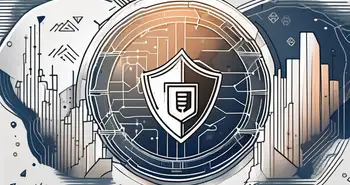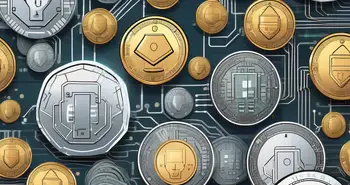Could a 51% Attack Be the End of Your Crypto?

Cryptocurrency has revolutionized the way we think about money and transactions. It has provided us with a decentralized and secure means of exchanging value. However, no system is entirely foolproof, and the risks associated with cryptocurrency cannot be overlooked. One such risk that often plagues the cryptocurrency world is the 51% attack. Today, we will delve into the depths of this attack, understanding its mechanics, potential risks, how to identify it, and most importantly, how we can mitigate its effects.
What is a 51% Attack?
A 51% attack occurs when a single entity or a group of entities gain control over more than 50% of a cryptocurrency network's computing power. In the context of blockchain technology, this means having the majority of the network's mining capabilities. This level of control allows the attacker to manipulate transactions, reverse completed transactions, and potentially double spend the same cryptocurrency.
The Concept of Blockchain and Cryptocurrency
Before diving further into the 51% attack, it's crucial to understand the underlying concepts of blockchain and cryptocurrency. Blockchain is a decentralized and distributed ledger that records transactions across multiple computers or nodes. It ensures transparency, security, and immutability. Cryptocurrency operates on blockchain technology as a digital medium of exchange.
The Mechanics of a 51% Attack
To execute a 51% attack, the attacker needs to accumulate enough computing power to control the majority of the network. This is achieved by either owning or renting a significant portion of the network's mining capabilities. Once in control, the attacker can begin to manipulate the blockchain by altering transaction details, excluding certain transactions, or even rewriting the entire transaction history.
As you can imagine, the consequences of such an attack can be severe, both for the network itself and its users. It undermines the decentralized nature of cryptocurrencies and introduces doubts regarding the immutability of transactions.
During my years of experience in the cryptocurrency world, I have seen firsthand the devastating impact of a 51% attack. It is a wake-up call for the industry and highlights the importance of taking necessary precautions to safeguard our digital assets.
Let's delve deeper into the mechanics of a 51% attack. The attacker, armed with their majority control, can exploit the network's consensus algorithm, which is the mechanism that ensures agreement among nodes on the validity of transactions. By controlling the majority, the attacker can dictate the outcome of this consensus, effectively overriding the decisions made by the honest participants in the network.
One method the attacker can employ is known as the “double spend” attack. This involves the attacker making a transaction on the blockchain, such as purchasing goods or services, and then secretly creating an alternate version of the blockchain where that transaction never happened. The attacker can then use their majority control to ensure that this alternate version becomes the dominant one, effectively erasing the original transaction from existence. This allows the attacker to retain both the goods or services they purchased and the cryptocurrency they used to pay for it, essentially creating money out of thin air.
Another potential consequence of a 51% attack is the ability to reverse completed transactions. Normally, once a transaction is confirmed and added to the blockchain, it is considered final and cannot be undone. However, with majority control, the attacker can rewrite the transaction history, effectively erasing any evidence of the completed transaction. This can lead to chaos and confusion within the network, as participants may find themselves questioning the validity of their own transactions.
It is important to note that executing a successful 51% attack is not an easy task. It requires a significant amount of computational power and resources, making it a costly endeavor. However, as the value of cryptocurrencies continues to rise, the potential rewards for such an attack also increase, making it a tempting target for malicious actors.
In conclusion, a 51% attack is a serious threat to the integrity and security of a cryptocurrency network. It highlights the need for constant vigilance and the implementation of robust security measures to protect against such attacks. As the cryptocurrency industry continues to evolve, it is imperative that we stay one step ahead of those who seek to exploit its vulnerabilities.
The Potential Risks of a 51% Attack
Now that we understand what a 51% attack is, let's explore the potential risks associated with such an attack.
Threat to Decentralization
Decentralization is one of the fundamental principles of cryptocurrency. It ensures that power and control are distributed among multiple participants, reducing the risk of a single point of failure. However, a successful 51% attack undermines this principle by concentrating power in the hands of a few, potentially leading to centralization.
In my opinion, one of the most critical aspects of cryptocurrency is its ability to empower individuals, giving them control over their finances. A 51% attack poses a significant threat to this empowerment.
Impact on Transaction Reversal
Another risk associated with a 51% attack is the ability to reverse completed transactions. In essence, the attacker can spend their cryptocurrency, then manipulate the blockchain to make it appear as if the transaction never occurred. This places trust in the system at risk, as users may believe that their transactions are irreversible.
Imagine a scenario where you sell a valuable item for cryptocurrency, only to find out later that the transaction has been reversed. It would not only be financially devastating, but also immensely frustrating. This is a reality that we must be aware of and guard against.
Implications for Double Spending
Double spending is another danger that arises from a successful 51% attack. By controlling the majority of the network's computing power, the attacker can spend the same cryptocurrency more than once, essentially creating counterfeit digital assets.
Implementing protective measures against the possibility of double spending is of utmost importance, as it directly impacts the trust and integrity of the entire cryptocurrency ecosystem.
How to Identify a 51% Attack
Being able to identify a potential 51% attack is crucial for early intervention. Here are some signs to look out for:
Unusual Blockchain Activity
An increase in mining activity from a single source can be a red flag. If a specific entity suddenly controls a significant portion of the network's mining power, it may indicate an attempt to execute a 51% attack.
Sudden Changes in Mining Power
A drastic surge or drop in the network's mining power can also be indicative of an ongoing 51% attack. This sudden change can be a result of an entity deliberately temporarily allocating more computing power to manipulate the blockchain.
Mitigating the Risks of a 51% Attack
While the risks of a 51% attack are significant, there are measures we can take to mitigate its effects.
Implementing Protective Measures
Blockchain protocols can be enhanced to prevent the occurrence of a 51% attack. Consensus mechanisms such as proof-of-stake (PoS) and decentralized checkpoints can provide greater security and make it economically infeasible for attackers to accumulate enough computing power.
Additionally, the implementation of automatic checkpoints can serve as a defense mechanism, protecting the blockchain from manipulation.
Role of Cryptocurrency Exchanges
Cryptocurrency exchanges play a crucial role in the security of the overall ecosystem. It is essential for exchanges to implement strong security measures and conduct thorough due diligence when listing new cryptocurrencies.
By only listing cryptocurrencies that have strong network hash rates and diverse mining pools, exchanges can reduce the risk of a successful 51% attack.
The Future of Cryptocurrency Security
The fight against 51% attacks is ongoing, and the cryptocurrency community is continuously innovating to enhance security. Here are some developments we can expect in the future:
Innovations in Blockchain Technology
Blockchain technology is constantly evolving, and new consensus mechanisms are being developed to strengthen security. These include hybrid models, advanced encryption algorithms, and improved network protocols. With these innovations, we can expect a higher level of resistance against 51% attacks.
Regulatory Measures and Cryptocurrency
As the cryptocurrency industry matures, regulatory measures are being put in place to safeguard the interests of users. Governments and regulatory bodies are taking a more active role in monitoring and preventing malicious activities, such as 51% attacks.
Although regulatory measures may introduce centralized control to some extent, they also provide a level of accountability and protection for cryptocurrency users.
FAQs
What is a 51% attack?
A 51% attack occurs when a single entity or a group of entities gain control over more than 50% of a cryptocurrency network's computing power, allowing them to manipulate transactions and potentially double spend the same cryptocurrency.
Why is a 51% attack a risk?
A successful 51% attack threatens the decentralization of cryptocurrencies, undermines transaction irreversibility, and enables the attacker to double spend the same cryptocurrency, compromising overall trust and integrity.
How can we identify a 51% attack?
Signs of a 51% attack include unusual blockchain activity, sudden changes in mining power, and an entity controlling a significant portion of the network's computing power.
What can be done to mitigate the risks of a 51% attack?
To mitigate the risks of a 51% attack, blockchain protocols can be enhanced with consensus mechanisms such as proof-of-stake (PoS) and decentralized checkpoints. Cryptocurrency exchanges can also play a role by implementing strong security measures and conducting due diligence when listing new cryptocurrencies.
How is cryptocurrency security evolving?
Cryptocurrency security is evolving through innovations in blockchain technology, which introduce new consensus mechanisms, encryption algorithms, and network protocols. Regulatory measures are also being established to protect cryptocurrency users from malicious activities such as 51% attacks.
In conclusion, understanding the risks of a 51% attack is crucial for anyone involved in the cryptocurrency world. By being aware of the potential threats and implementing appropriate measures, we can work towards a more secure and decentralized future for digital assets. As an expert in the field, I have witnessed the impact of 51% attacks and advise all cryptocurrency enthusiasts to stay informed, remain vigilant, and actively contribute to the development of robust security measures. Our shared efforts will help safeguard the integrity and trust in cryptocurrencies, ensuring their widespread adoption and success.
As we navigate the complexities of cryptocurrency security and the risks of 51% attacks, it's essential to choose a trading platform that not only understands these challenges but also provides innovative solutions. Morpher stands out as a revolutionary platform that leverages blockchain technology to offer a safe, fee-free, and versatile trading experience. With features like infinite liquidity, fractional investing, and up to 10x leverage, Morpher empowers you to trade confidently across various asset classes. Embrace the future of trading with Morpher's unique Virtual Futures and take control of your investments with the non-custodial Morpher Wallet. Sign Up and Get Your Free Sign Up Bonus today, and join the community that's shaping the next generation of investing.

Disclaimer: All investments involve risk, and the past performance of a security, industry, sector, market, financial product, trading strategy, or individual’s trading does not guarantee future results or returns. Investors are fully responsible for any investment decisions they make. Such decisions should be based solely on an evaluation of their financial circumstances, investment objectives, risk tolerance, and liquidity needs. This post does not constitute investment advice.

Painless trading for everyone
Hundreds of markets all in one place - Apple, Bitcoin, Gold, Watches, NFTs, Sneakers and so much more.

Painless trading for everyone
Hundreds of markets all in one place - Apple, Bitcoin, Gold, Watches, NFTs, Sneakers and so much more.









